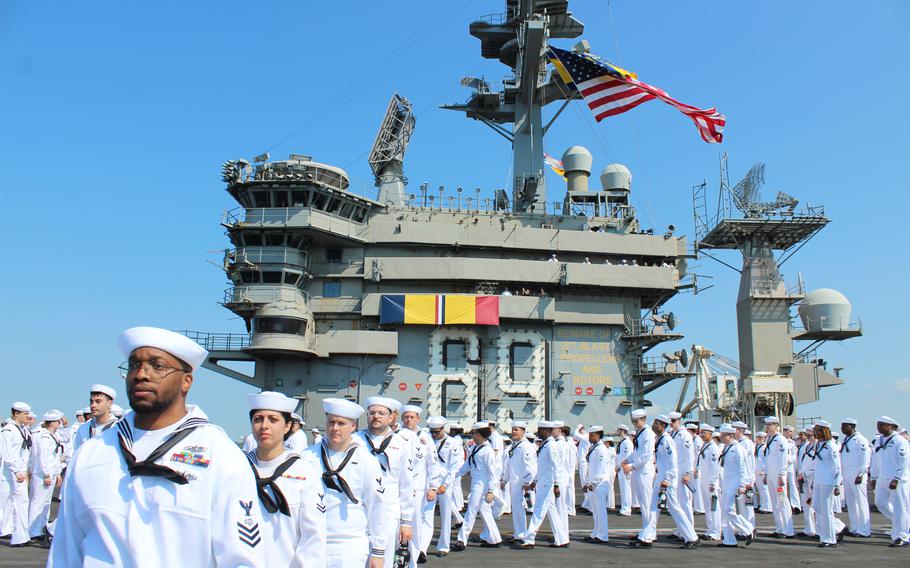
Sailors aboard the USS Dwight D. Eisenhower begin to man the rails on Sunday, July 14, 2024, as the aircraft carrier approaches Naval Station Norfolk, Va. A banner replica of the combat action ribbon was strung across the island of the ship. The Eisenhower returned to Norfolk from a twice-extended deployment to the Red Sea where it defended other ships against almost daily attacks from Houthi rebels in Yemen. (Caitlyn Burchett/Stars and Stripes)
NORFOLK, Va. — Sailors, donning white dress uniforms, crowded the bow of USS Dwight D. Eisenhower on Sunday, with chants of “USA! USA!” spread from shore to the aircraft carrier, rippling through the crew on the flight deck.
Strung up across the island of the warship was a unique rectangular banner — a giant replica of the combat action ribbon that many sailors were already sporting on their chests.
The Eisenhower and about 5,000 sailors returned from what senior U.S. officials are calling a “deployment of firsts” following nine months at sea, seven of which were in a combat zone.
The aging warship and components of its strike group saw the first air-to-air engagement against drones and the first combat employment of the precision-guided Joint Direct Attack Munition bombs as the carrier defended merchant ships against almost daily attacks in the Red Sea from Houthi rebels in Yemen.
The carrier’s deployment to the Middle East was scheduled for Oct. 14, though it followed an unexpected deadly attack on Israel one week before that set off a wave of tensions and hostilities throughout the region.
“On Oct. 7, everything changed,” said Capt. Christopher Hill, commanding officer of the Eisenhower. “We didn’t know yet what they were going to ask us to do, but we knew it would likely have something to do with participating in that conflict.”
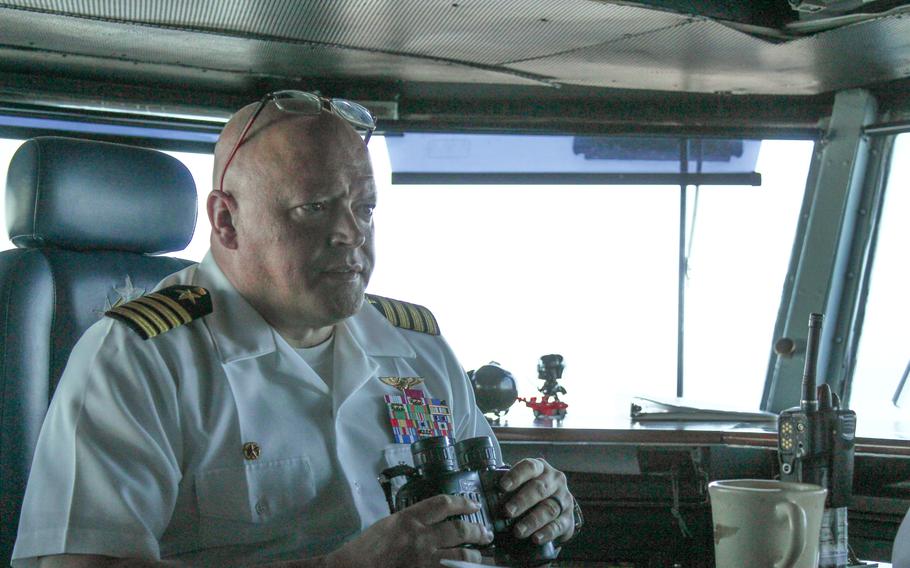
Capt. Christopher Hill sits in the bridge of the USS Dwight D. Eisenhower on Sunday, July 14, 2024. The Eisenhower returned to Naval Station Norfolk, Va., from a deployment to the Red Sea. (Caitlyn Burchett/Stars and Stripes)
The deployment for the Eisenhower strike group became a series of clashes with the Iran-backed Houthis, a group designated a terrorist organization by the U.S. in January. The U.S.-led campaign against the Houthi rebels, overshadowed by the Israel-Hamas war in the Gaza Strip, has turned into the most intense running sea battle that the Navy has faced in nearly eight decades, service leaders and experts told The Associated Press.
U.S. Central Command, which oversees military operations in the Middle East, reported almost daily instances of missiles being fired toward Navy ships for seven of the nine months that the Eisenhower was deployed to the region. The strike group defended merchant vessels and military ships traveling through the Suez Canal that were the target of attack drones and anti-ship missiles launched from Houthis.
The intense combat pace meant scheduled port calls were canceled multiple times. Sailors aboard the Eisenhower spent six months at sea before they set foot on land, visiting Greece in late April.
“But this gave us mission and purpose,” Hill said. “We were going to provide freedom of navigation, which is sort of the core mission of the United States Navy, going back to 1775.”
Aboard the Eisenhower, dozens of references to the Red Sea mission can be found.
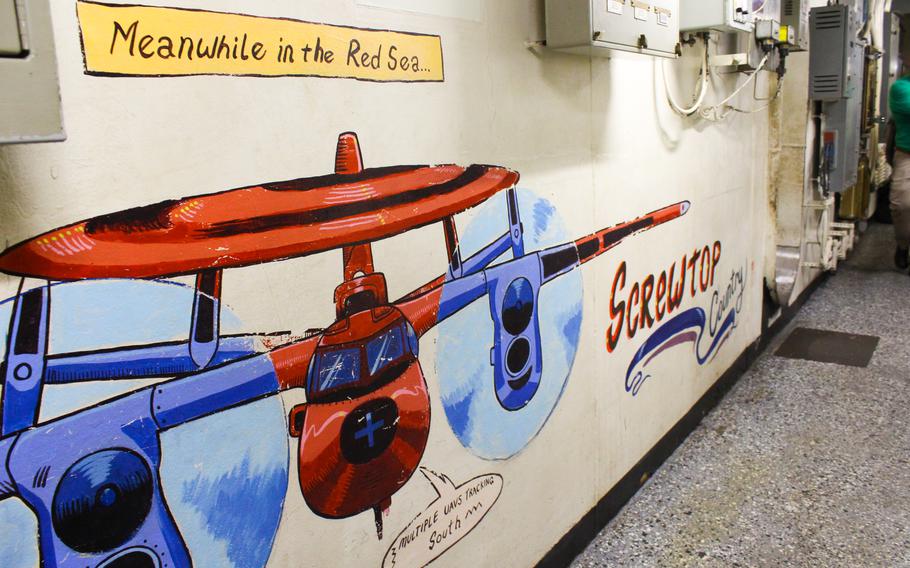
Wall art in a hallway of the USS Dwight D. Eisenhower shows a surveillance C-2 Hawkeye plane. In reference to the Houthi attacks, the art reads: “Meanwhile in the Red Sea... multiple unmanned aerial vehicles (UAVs) tracking south.” (Caitlyn Burchett/Stars and Stripes)
Wall art depicting a surveillance C-2 Hawkeye plane reads: “Meanwhile in the Red Sea... multiple unmanned aerial vehicles (UAVs) tracking south.”
Sailors’ water bottles and jackets were adorned with “Attack of the drones” patches and stickers.
The maintenance desks of aircraft squadrons were lined with victory marks akin to those affixed to their aircraft. At the maintenance desk for the Strike Fighter Squadron 131, known as the “Wildcats,” red and blue stencils of bombs and missiles representing successful combat engagements covered the wall from the ceiling to the floor.
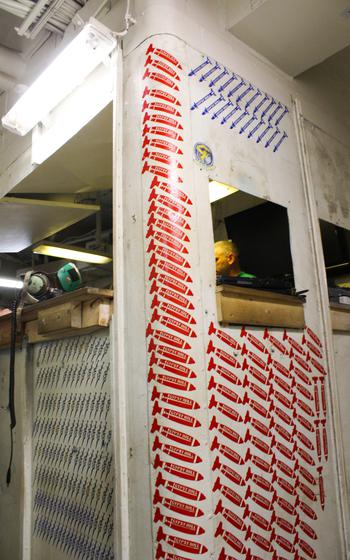
The maintenance desks of aircraft squadrons aboard the USS Dwight D. Eisenhower were lined with victory marks akin to those affixed to their aircraft. At the maintenance desk for Strike Fighter Squadron 131 “Wildcats,” red and blue stencils covered the wall. (Caitlyn Burchett/Stars and Stripes)
The references were a creative way for sailors to make the best of a serious situation, according to Capt. Edward Pledger, commander of the strike group’s Destroyer Squadron 22.
“As our commanders have said, we had to be right every single time. The Houthis only have to be right once,” he said.
When the strike group’s advanced 3D radar system begins to track a potential weapon traveling at a Mach 3-5 speed, Pledger said, sailors can have only seconds to identify the threat. After seven months spent battling Houthi attacks, he said reacting has become instinctive for the crews of the Eisenhower carrier strike group.
Pledger did not say how close Houthi missiles and drones were to U.S. ships at the time they were shot down, but he said crews on the destroyers could sometimes watch ships and F-18 fighter jets taking out the enemy weapons.
“We have ships and sailors that have operated in the heart of the Houthi weapon engagement zone for days and weeks and months knowing they were going to get shot at – and did get shot at. Those sailors never flinched,” he said.
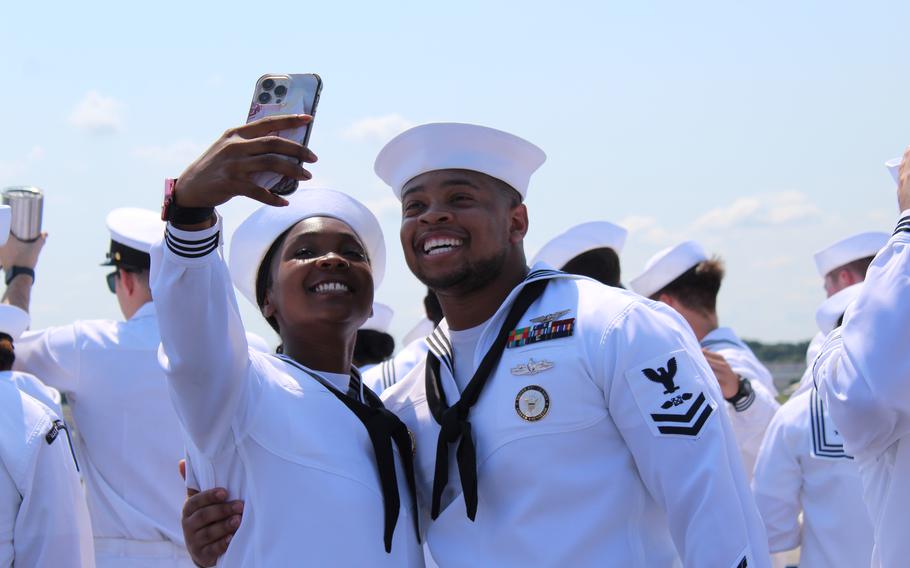
Sailors take a photo while waiting to disembark the USS Dwight D. Eisenhower. The aircraft carrier returned Sunday, July 14, 2024, to Naval Station Norfolk, Va., from a deployment to the Red Sea. (Caitlyn Burchett/Stars and Stripes)
The group’s air wing expended 60 air-to-air missiles and released 420 air-to-surface weapons. All told, the strike group completed more than 13,800 flights totaling about 31,500 hours.
The strike group included the Eisenhower, the guided-missile cruiser USS Philippine Sea, guided-missile destroyers USS Mason and USS Gravely of Destroyer Squadron 22. Also part of the strike group was Air Wing 3, which was comprised of nine squadrons.
The USS Theodore Roosevelt, a West Coast-based carrier, was diverted from the Pacific to relieve the Eisenhower. The USS Harry S. Truman will deploy from Naval Station Norfolk, Va., to the Mediterranean Sea later this year.
On Sunday, sailors toting their green seabags crossed the brow of the ship and made their way to their loved ones.
Down the pier, Callie Bell stood on her tiptoes in search of her husband. She clutched her toddler’s hand with her right hand and a sign in her left. The sign, reading “my faith did not fail,” was crumpled and frayed from hours spent carrying it around.
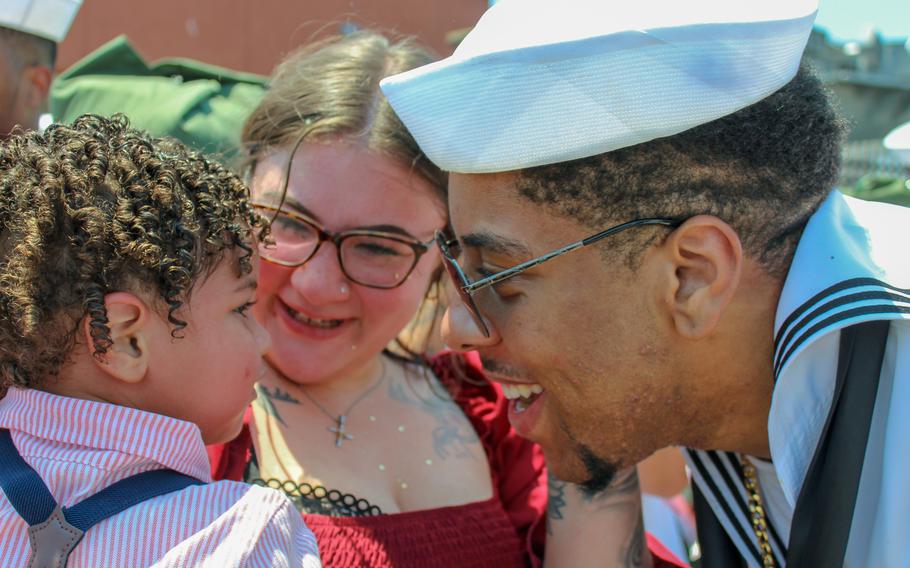
Aviation boatswain’s mate Kei-Ard Bell greets his wife Callie Bell and their 1-year-old son Malachi at Naval Station Norfolk, Va., on Sunday, July 14, 2024. The USS Dwight D. Eisenhower and about 5,000 sailors returned home from a deployment to the Red Sea. (Caitlyn Burchett/Stars and Stripes)
“Before my husband left, he promised to come back to us and we promised to be here. But with everything happening, it felt like nothing was certain,” Bell said, tears streaming down her cheeks.
Several minutes later, her husband, aviation boatswain’s mate Kei-Ard Bell, pushed his way through a sea of sailors and hugged and kissed his family for the first time in nine months.
After a long hug, the sailor said to his family, “Let’s go home.”